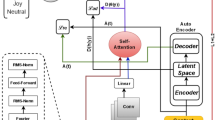Abstract
Most of the previous emotion classifications are based on binary or ternary classifications, and the final emotion classification results contain only one type of emotion. There is little research on multi-emotional coexistence, which has certain limitations on the restoration of human’s true emotions. Aiming at these deficiencies, this paper proposes a Bidirectional Long-Short Term Memory Multiple Classifiers (BLSTM-MC) model to study the five classification problems in code-switching text, and obtains text contextual relations through BLSTM-MC model. It fully considers the relationship between different emotions in a single post, at the same time, the Attention mechanism is introduced to find the importance of different features and predict all emotions expressed by each post. The model achieved third place in all submissions in the conference NLP&&CC_task1 2018.
Access this chapter
Tax calculation will be finalised at checkout
Purchases are for personal use only
Similar content being viewed by others
References
Parrott, W.: Emotions in Social Psychology: Essential Readings, pp. 1–392. Psychology Press, Philadelphia (2001)
Tang, D., Qin, B., Liu, T.: Deep Learning for sentiment analysis: successful approaches and future challenges. Wiley Interdisc. Rev. Data Min. Knowl. Discov. 5(6), 292–303 (2015)
Socher, R., Huval, B., Manning, C.D., et al.: Semantic compositionality through recursive matrix-vector spaces. In: Proceedings of the Joint Conference on Empirical Methods in Natural Language Processing and Computational Natural Language Learning, pp. 1201–1211. MIT Press, Cambridge (2012)
Kim, Y.: Convolutional neural networks for sentence classification (2014). ar**v:1408.5882
Zhu, X., Sobihani, P., Guo, H.: Long short-term memory over recursive structures. In: Proceedings of the International Conference on Machine Learning, pp. 1604–1612. ACM, New York (2015)
Cheng, J.: Research on two-dimensional LSTM model based on attention mechanism in sentiment classification of Chinese commodity reviews. Softw. Eng. 20(11), 4–6 (2017)
Mikolov, T., Sutskever, I., Chen, K., et al.: Distributed representations of words and phrases and their compositionality. In: Proceedings of NIPS, pp. 3111–3119 (2013)
Collobert, R., Weston, J., Bottou, L., et al.: Natural language processing (Almost) from scratch. J. Mach. Learn. Res. 12(1), 2493–2537 (2011)
Kalchbrenner, N., Grefenstette, E., Blunsom, P.: A convolutional neural network for modelling sentences, p. 1. Eprint Arxiv (2014)
Lai, S., Xu, L., Liu, K., et al.: Recurrent convolutional neural network for text classification. In: Proceedings of the Twenty-Ninth AAAI Conference on Artificial Intelligence, pp. 2267–2273 (2015)
Teng, Z., Vo, D.T., Zhang, Y.: Context-sensitive lexicon features for neural sentiment analysis. In: Proceedings of the 2016 Conference on Empirical Methods in Natural Language Processing, pp. 1629–1638 (2016)
Elman, J.L.: Finding structure in time. Cogn. Sci. 14(2), 179–211 (1990)
Gers, F.A., Schmidhuber, J., Cummins, F.: Learning to forget: continual prediction with LSTM. Neural Comput. 12(10), 2451–2471 (2000)
Mnih, V., Heess, N., Graves, A., et al.: Recurrent models of visual attention. In: Advances in Neural Information Processing Systems 27 (NIPS), pp. 2204–2212 (2014)
Xu, K., Ba, J., Kiros, R., et al.: Show, attend and tell: neural image caption generational with visual attention. In: Proceedings of the 32nd International Conference on Machine Learning (ICML), pp. 2048–2057 (2015)
Zheng, X., Ding, L., Wan, R.: Hierarchical BGRU model based on user and product attention mechanism. Comput. Eng. Appl., 27 May 2017
Zhang, Y., Jiang, Q.: Textual sentiment analysis based on two LSTM structures. Software 1, 116–120 (2018)
Liu, Y., Ouyang, C., Li, J.: Ensemble method to joint inference for knowledge extraction. Expert Syst. Appl. 83, 114–121 (2017)
Acknowledgements
This research work is supported by National Natural Science Foundation of China (No. 61402220, No. 61502221), the Philosophy and Social Science Foundation of Hunan Province (No. 16YBA323), the Double First Class Construct Program of USC (2017SYL16), scientific and technological research program of Chongqing municipal education commission (No. KJ1500438), basic and frontier research project of Chongqing, China (No. cstc2015jcyjA40018).
Author information
Authors and Affiliations
Copyright information
© 2018 Springer Nature Switzerland AG
About this paper
Cite this paper
Wang, T., Yang, X., Ouyang, C., Guo, A., Liu, Y., Li, Z. (2018). A Multi-emotion Classification Method Based on BLSTM-MC in Code-Switching Text. In: Zhang, M., Ng, V., Zhao, D., Li, S., Zan, H. (eds) Natural Language Processing and Chinese Computing. NLPCC 2018. Lecture Notes in Computer Science(), vol 11109. Springer, Cham. https://doi.org/10.1007/978-3-319-99501-4_16
Download citation
DOI: https://doi.org/10.1007/978-3-319-99501-4_16
Published:
Publisher Name: Springer, Cham
Print ISBN: 978-3-319-99500-7
Online ISBN: 978-3-319-99501-4
eBook Packages: Computer ScienceComputer Science (R0)





